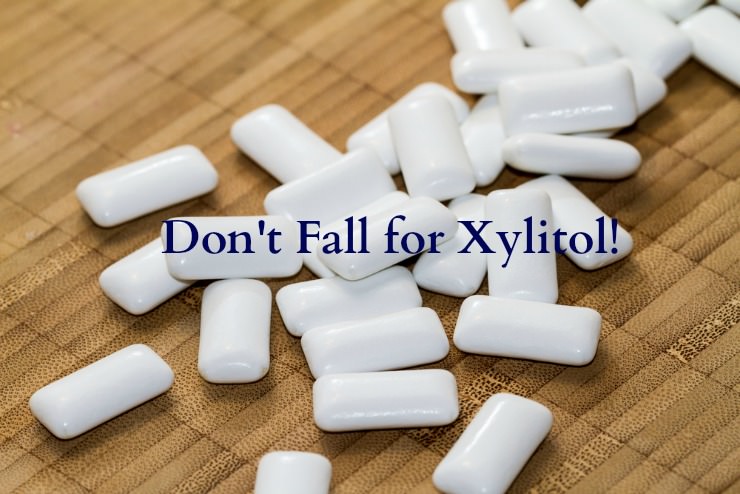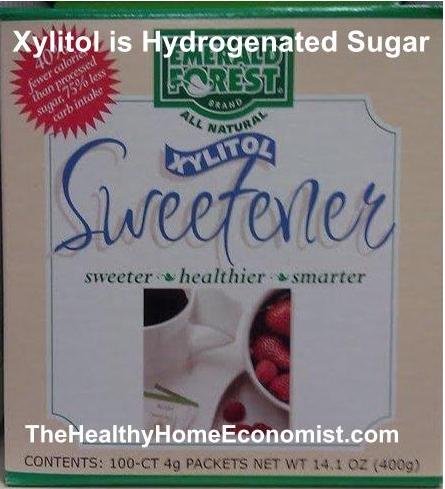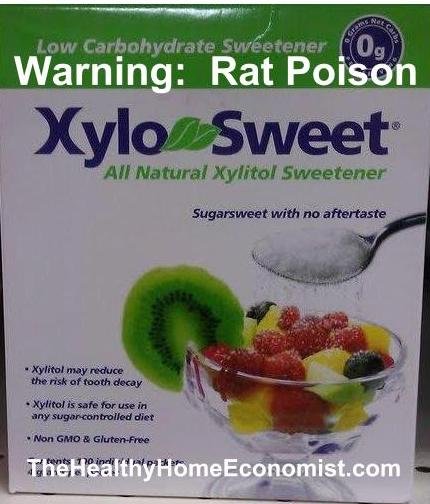
Xylitol is truly the darling of sugar substitutes today. The American Dietetic Association touts its use, with this sugar alcohol sold alone and as a sweetener in a variety of processed foods. Health benefits include a reduced glycemic response compared with sucrose, increased absorption of B vitamins and calcium, and even a reduction in dental caries risk.
Consequently, people with blood sugar issues are flocking to processed foods containing this alternative sweetener as a way to satisfy that sweet tooth without the downside of exacerbating the risk factors for Metabolic Syndrome. This condition is known for the markedly increased likelihood of developing heart disease, stroke, and type 2 diabetes.
Even the healthfood community almost universally considers this sugar alcohol to be a healthy substitute for sugar. A primary reason is that it doesn’t directly contribute toward the growth of intestinal yeasts aka Candida.
Have you noticed that the check out aisles at health food stores are typically loaded with chocolates and other sweets containing at least some xylitol? The truth is that I have yet to talk with any health-conscious person who suggests to me any downside other than the potential for intestinal cramps if you get too much.
Xylitol is Naturally Found in Nature
Xylitol is, after all, a naturally occurring substance. Manufacturers of xylitol market it as derived from xylan. The fibers of many plants contain it, including berries, oats, beets, sugar cane and birch. Sounds pretty harmless at first glance.
The FDA has even granted xylitol GRAS (Generally Recognized As Safe) status. You can’t get any safer than that, right?
 Manufacturing Process
Manufacturing Process
It is true that xylitol is a naturally occurring substance. However, manufactured xylitol is another matter entirely. Food manufacturers produce it using the industrialized process of sugar hydrogenation. In order to hydrogenate anything, a catalyst is needed. In this case, Raney nickel is used which is a powdered nickel-aluminum alloy. (1, 2)
This poses the risk of heavy metal residue and contamination. Nickel, by the way, is a recognized carcinogen and aluminum is associated with the development of dementia. Heavy metals in the body are notoriously difficult to eliminate with frequent use of infrared sauna probably a good idea.
This alternative sweetener doesn’t seem quite so warm and fuzzy anymore, does it?
There is currently no literature on any detrimental health effects of consuming hydrogenated sugar. However, food manufacturers widely used hydrogenated fats for decades before the very damaging effects of cardiovascular health became widely known!
Given the violent industrialized process that is required to produce a hydrogenated sugar like xylitol, it would seem wise to avoid it based on the very poor track record of hydrogenated foods in general.
Most Xylitol Sourced from GMO Corn
While it is true that xylitol can be derived from the xylan of birch trees, xylan is also found in corn cobs. It is much cheaper to use corn instead of birch bark to derive xylitol and so what do you think manufacturers prefer? Corn, of course.
Therefore, unless the label of a xylitol-containing product specifically notes that it is from birch or another nonGMO source, xylitol is very likely from genetically modified corn or possibly GMO sugar beets.
This is the same problem as high fructose corn syrup (HFCS) and white sugar from beets. Food manufacturers rely heavily on these sweeteners in the production of sodas and sports drinks.
You get a dose of GMOs with every sip! More on GMO dangers including sterility and stomach holes at the provided link.
Usage Contributes to Gut Imbalance
The digestive process does not break down sugar alcohols like food. Rather, xylitol arrives intact into the intestines.
At that point, a process called “passive diffusion” takes place. This means that the xylitol draws water into the bowels. Only a partial breakdown is the end result. The unmetabolized portion ferments providing the perfect environment for undesirable bacteria to thrive and grow.
It is true that xylitol itself does not feed candida directly as sugar does. As a result, this artificial sweetener is even promoted as a useful part of the Candida Diet. Unfortunately, the fermentation of undigested xylitol in the gut most definitely can exacerbate yeast problems. Don’t be fooled by this argument!
This is exactly why consuming xylitol can make some folks so gassy and even trigger cramping and diarrhea. Gut pathogens having a heyday in your intestines give off a lot of smelly toxins!
Other Little Known Problems
Xylitol can contribute to acid reflux problems. As a result, those who have issues in this area should avoid it for that reason alone. Chronic acid reflux is a serious problem that can lead to cancer of the esophagus and larynx.
In addition, those who suffer from seizures of any kind should stay away from this alternative sweetener as it can increase the frequency of epileptic attacks.
Two Pieces of Xylitol Gum Can Kill a Rat?
According to unpublished lab tests, approximately 1.65 grams of xylitol kills a 100-gram rat half the time.
Two little pieces of xylitol gum contain about .7 – 1 gram. This is probably enough to meet the definition of rat poison.

Cavity Prevention
Many people are chewing xylitol gum due to compelling scientific evidence for cavity prevention. What about children, however?
Rami Nagel, author of Cure Tooth Decay, doesn’t even recommend xylitol gum for this purpose. His research for any long term safety data turned up the following:
- Epidemiology: No information found
- Teratogenicity: No information found
- Reproductive Effects: No information found
- Mutagenicity: No information found
- Neurotoxicity: No information found
In summary, using this modern substance officially renders you a guinea pig, my friend! It seems that any benefits of cavity prevention are outweighed by the fact that there is no actual safety data backing up its use.
Safe Uses of Xylitol
Given all the problems that consumption of xylitol can trigger, it seems best to bypass the use of this sugar substitute on a regular basis.
Can it ever be helpful? Does it have any benefits whatsoever?
Potentially so. The only time I personally would ever consider using xylitol is to help resolve a childhood ear or sinus infection in order to prevent the use of drug-based antibiotics.
There is evidence that this popular sugar alcohol can indeed help encourage a healthy balance of beneficial bacteria found in the ear canal and sinus cavities. Products like this incorporate xylitol for this purpose.
A therapeutic dose can help resolve infection in these areas quickly with no medication required.
Thus, if you choose to use it, make sure it is sparingly and therapeutically (not as food). Also, make sure it does not come from a GMO source like corn!
References
(1) Xylitol production via catalytic hydrogenation of sugarcane
(2) Catalytic hydrogenation of xylose to xylitol using ruthenium catalyst on NiO modified TiO2 support
(3) Cure Tooth Decay by Rami Nagel
(4) Sugar-Free Blues: Everything You Wanted to Know about Artificial Sweeteners
More Information
Yacon: Healthy Syrup or Healthfood Hype?
Jaggery: India’s Sweet Gift








Hi Sarah:
Is xytiol necessary for preventing tooth decay? Using Ramiel Nagel’s diet for reversing tooth decay, taking mincol, and using other measures like oil pulling should do the trick. These measures have properties of healing the entire body, as opposed to treating a symptom, so I would start with these first.
I think this is an isolated compound and too often these isolated compounds do more harm than good. Their action becomes more like a drug than a food, which means much more room for negative side effects.
One of the less known reasons why people crave sweets is because many foods have lost the natural sweetness from being nutrient deficient because of inept soil management practices, not excluding the vast majority of organic farming out there. Have you tasted celery or broccoli grown in healthy fertile soil that is sweet like an orange? I have found people gravitate toward such superior foods when they are presented to them, which in turn satisfy their sweet tooth.
Sarah, I wish you had mentioned more about the research and usage of Xylitol in Europe. When I started using it several years ago for a sweetner for my family and diabetic daughter, I spent hours looking at information on the web about its safety and usage. I read many articles about how it had been used for over 50 years in Europe and was even used as medicine for children with chronic ear infections. I find your information a stark contrast to all the good things I read a few years ago. After pondering over it for a while, I am wondering if in Europe, they processed natural Xylitol from the original sources of Birch and Raspberry to create theirs while in America, the companies have found ways to make it faster and cheaper. The American processing and advertising could very well be what has lead to the increased usage of Xylitol in almost everything and the reports as you stated above about all of the negative aspects about Xylitol. As you don’t mention any more articles that you sourced your info from than 3, I am not sure that the whole picture is being portrayed here. I would be very interested in finding out if you had done more research about the European use and processing of Xylitol. I use it in my home and really would like the whole story. Thank you for thinking about our safety and reporting these things to your avid readers.
Just FYI for anyone out there looking for good natural toothpastes: my sis and I love Uncle Harrry’s toothpastes. You can buy them online from uncleharrys.com if they aren’t available in any local stores. They’re clay-based and all natural, so no artificial sweeteners like xylitol and whatnot. The texture is different than conventional toothpastes, but I love them and feel like they take better care of my teeth. Also, Dr. Bronner’s and other Castile soaps can also be used as toothpaste.
another good clay-based one is Redmond’s Earthpaste (the cinnamon is yum)! 🙂
ok never mind…Earthpaste has xylitol…arr!
I too would like to know about Lakanto…as I have found it to be an awesome replacement for sugar although it is expensive….Can you let us know Sarah?
Any-thing in your mouth goes directly into your blood and to your brain so quickly!
The whole principle behind homeopathics under the tongue.
Regardless of spitting!
Even a small amount of xylitol (or any other sugar alcohol, for that matter) causes me severe intestinal distress, which is why I use strictly stevia for my sweetener (coffee, tea, baking), or honey when baking for groups. I wish stevia was easier for me to grow (I can’t get it to germinate hardly at all!) because it is so pricey to purchase!
I wonder if Lakanto sweetener is produced in the same way as xylitol. I’d love to know. It’s by-product is erythritol, an alcohol sugar. It is promoted by Donna Gates and sold on her Body Ecology website.
Reading through the comments, I sense in many posts a sense of desperation…”What am I going to do if I can’t have my sweets and not pay a price for it?!”
I certainly relate to “needing” sweets. I tell myself I don’t eat much of them, but every night after dinner I crave for them. I don’t need much…a couple pieces of dark chocolate or a couple dates are common. I’ve known people who have completely cut any and all sugars from their diet (including fruit, sugar substitutes, honey, dates, fruit juices, etc). I mean everything! And they say how much better they feel in generally, more stable energy, no more cravings, etc. I just haven’t been able to bring myself to do that. I notice that even if I do eat something larger/sweeter (such as a piece of pie), as long as I do it during a larger meal (such as the evening meal for us), I don’t get all wonked out (sugar rush/crash)
But what of the logic of “sugar substitutes”? Is it so one can eat LOTS of sweet stuff and not pay the health price that Sarah reminded us all of?
Of course there are the “healthier” sugars such as molasses and the dark sugar crystals such as Rapadura or Sucanat. These are much less processed than white sugar or the nearly white sugars such as Florida Crystals or what is often labeled as Organic Sugar. Molasses is actually the stuff taken out during the purifying of white sugar and contains a lot of minerals, but it has a taste fitting for some recipes, such as molasses cookies, or you could just get used to it.
When we bake sweets at home (which is rare), we use whatever we have on hand. We use honey, organic off-white sugar, dates or Sucanat. No fake sugars. Neither of us has diabetes or blood sugar problems. We don’t worry too much about how nutrient-dense the sweetener we are using, though we certainly don’t use regular white sugar. We don’t eat too much of the home baked.
My wife eats far less sweets than I do. I do have to stay away from things like cookies, because I just turn into the cookie monster! It’s funny though, because I actually prefer my desserts to be not too sweet, but most store bought cookies (aka Pamela’s choc chip) are certainly very sweet. Cookies for me seem to trigger that sort of mindless eating where I have eaten 3 or 4 cookies in a matter of 2 minutes and I haven’t had my evening meal yet. In Germany a few years ago, I went for a hike. I first stopped at the non-health-food grocery store and bought some things for a lunch. I also bought what looked like a peach puff pastry because I wanted a sweet and all the German baked goods were so good (yup, white sugar and white flour, except for their sourdoughs). I was pleasantly surprised when I bit into the pastry during my lunch break and noted how not-sweet it was. It was really good. It was made in the in-store bakery and had a list of ingredients on it. Out of the the 6 or 7 ingredients, the last one was “Zucker” (Sugar). I bet if American tastebuds where more like the Germans, we’d have a whole lot less diabetes, Sucanat or not. It’s ironic, too, because I had assumed that the German baked goods where just as sweet if not more so than standard American sweets.
I cut out ALL forms of sugar and sweetner completely for about 6 months. It wasn’t as hard as it sounds, but I did often tire of eating so many things that tasted bitter. Sometimes I just wanted some relief from bitter.
Not eating anything sweetened opens your tastebuds up to things that are naturally sweet. Most food tastes so much better and more intense. Who knew brussels sprouts taste like they have sugar sprinkled on them? But it also seemed to magnify bitter flavors–behind the sweetness of brussels sprouts there’s a hint of bitterness, too. On the rare occasion I’d taste something actually sweetened, it tasted horribly sweet, too much! I find I can also smell sugar and sweetener now–it’s not a pleasant smell.
BUT, sometimes it’s just nice to have a treat. This winter I’ve been wanting some hot chocolate, for example. I make it with cocoa powder and coconut butter. It’s tolerable without being sweetened, but so nice with just a tiny bit of sweetness to counteract the bitter. Or I’ve made a homemade grain free “nutola”, but it’s not pleasant without a tiny bit of sweet.
Dr. Jay Wortman (a physician who treats metabolic obesity–see the documentary “My Big Fat Diet”) says that he prefers his patients use artificial sweeteners rather than sugar in any form because while there’s speculation that AS may not be safe “we KNOW sugar is not safe.” It’s a little extreme, but it gets the point across.
A little xylitol goes a long way–I use a fraction of what most recipes call for in the occasional things I use it in. For me, with metabolic issues and poor tolerance to sugar in any form, the ability to have a taste good sweetener like xylitol is a very nice–and very occasional–treat. I know I can survive without it, but life is better if I don’t have to.